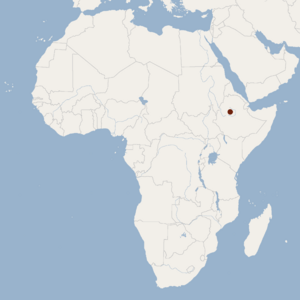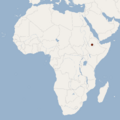Ethiopian amphibious rat facts for kids
Quick facts for kids Ethiopian amphibious ratTemporal range: Recent
|
|
|---|---|
| Conservation status | |
| Scientific classification | |
| Genus: |
Nilopegamys
|
| Species: |
plumbeus
|
 |
|
| Range according to Happold, 2013 | |
The Ethiopian amphibious rat, also known as the Ethiopian water mouse, is a very rare type of rodent. Its scientific name is Nilopegamys plumbeus. This rat is special because it eats mostly insects and lives partly in water (it's semiaquatic). It's the only known species in its group, called Nilopegamys, which belongs to the Muridae family (a large group of mice and rats).
So far, only one Ethiopian amphibious rat has ever been found! It was discovered in 1928 by Wilfred H. Osgood. He found it near the Lesser Abay River in the highlands of northwestern Ethiopia, about 2,600 meters (8,500 feet) above sea level. Scientists believe this rat is the most water-adapted African rat. Its unusually large brain might be a result of its watery lifestyle. Sadly, this species is thought to be critically endangered or even possibly extinct. This is because its home has been badly damaged by too much overgrazing by livestock and by growing only one type of crop (monoculture).
Contents
Finding the Ethiopian Water Rat
In late March 1928, the Ethiopian amphibious rat was first recorded. Wilfred H. Osgood found the single specimen in a trap. It was unlike any African rat he had ever seen. This rat showed many special features for living in water. This was very unusual for rats in Africa. Water-loving rats had been seen in South America before, but never in East Africa.
The Ethiopian amphibious rat has been seen only a few times in the wild. It has been spotted in the wet areas of the Ethiopian highlands. The only known specimen was found near the Lesser Abay River in central Ethiopia. This rat is listed as critically endangered. However, many scientists who study rodents worry it might already be extinct. This is because two attempts to find and track the rat have failed.
How It's Built for Water
The Ethiopian amphibious rat (Nilopegamys plumbeus) has special body parts that help it live near or in water. Other rodents, like the marsh rice rat or the European water vole, also live in wetlands. But out of all African water rodents, the Ethiopian amphibious rat has the most extreme adaptations for its environment.
It has special "waders" on its feet, which are actually webbing. This webbing helps it swim. Because N. plumbeus is so perfectly adapted to its specific home, it's very hard for it to live anywhere else. This is why scientists think that with its habitat being destroyed, this rat is now probably extinct.
This rat belongs to the Muridae family. It has the largest brain size of any African mouse or rat ever studied. Its brain is also very large compared to its body size, especially when you compare it to other water-living rodents.
Is It Still Around?
Dangers It Faces
The main reason the Ethiopian amphibious rat's population has likely dropped is habitat loss. We don't know much about how many of these rats existed before. But we can say their numbers have probably fallen a lot because their home has been destroyed. The biggest cause for the destruction of the Ethiopian highland wetlands is clearing land for livestock to graze. The rat's home is almost completely gone because of this grazing. Very little is being done to protect it. Ranching has also hurt its habitat, but not as much.
What We Can Do
Right now, there isn't much in place to help save the Ethiopian amphibious rat. The IUCN Red List says it is critically endangered, and possibly even extinct. Also, very little research has been done on this species. Currently, Julian Kerbis Peterhans at the Field Museum in Chicago, USA, is studying small mammals in the East African highlands. Almost everything we know about this rat comes from that single study done in the 1920s. More research is needed to learn about this species, its habits, and its environment.
Images for kids



